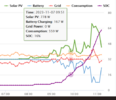Just a thought... In terms of efficiency, I believe that solar thermal is more effective at water heating, even in winter, than solar pv...
My daughter has solar water heating in Turkey and it works well, but father-in-law had it in North Wales and best it could do was remove the chill. Two large panels with pumps and a controller all professionally fitted, we got another installer to re-do the power bleeding etc, still did not heat the domestic hot water, they had removed the immersion heater when the solar was fitted, and father-in-law noted a reduction is electric use, until smart meters fitted and then no hot water, pilot flame in boiler went out. The system looked the part, when he died new owners of his house ripped it all out.
If I look at my solar PV today

it looks like a saw tooth, but when it does produce it goes direct into the system and can't reverse and send it back to solar panels, but with water a sensor has to detect the water is hot in the panels before starting the pump to circulate the water, or it can cool instead of heat the water.
If the panels are at ground level so you can use thermo syphon then a simple radiator painted black under a double glazed window would work, and in Turkey with a flat roof it was easy to bleed the panels at the top, all maintenance was easy, no need for scaffold and the like.
I note every time I drive to Welshpool one house with PV solar panels in their garden, easy to maintain and not over shadowed, but my garden has trees in it, and a hedge so would not get enough sun.
The wires to my solar panels need no lagging, and the system when sun lot shining uses very little energy, I would think the pumps on my father-in-laws solar panels used more power than the panels produced. He did live in Mold about as far north in Wales as you can get, had he lived down south they may have worked.


